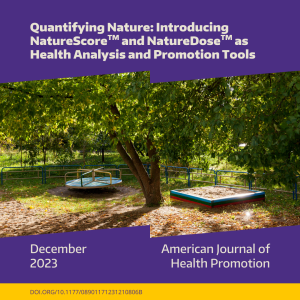Quantifying Nature: Introducing NatureScoreTM and NatureDoseTM as Health Analysis and Promotion Tools
Citation
Browning, M. H., Hanley, J. R., Bailey, C. R., Beatley, T., Gailey, S., Hipp, J. A., Kahn, P. H., … & Minson, C. T. (2024). Quantifying Nature: Introducing NatureScoreTM and NatureDoseTM as Health Analysis and Promotion Tools. American Journal of Health Promotion, 38(1), 126-134. doi.org/10.1177/08901171231210806b
 To use nature as a tool for better health, we need simple and reliable ways to measure how much nature people experience in their daily lives. Recent advances in mapping technologies, tracking methods, and data analysis are making this possible. NatureQuant, a research and technology group, was created to develop tools that can measure nature exposure more accurately and conveniently.
To use nature as a tool for better health, we need simple and reliable ways to measure how much nature people experience in their daily lives. Recent advances in mapping technologies, tracking methods, and data analysis are making this possible. NatureQuant, a research and technology group, was created to develop tools that can measure nature exposure more accurately and conveniently.
They have introduced two technologies. The first is NatureScore, which rates how much nature is present in any given location. The second is NatureDose, a mobile app that uses NatureScore data to track how much nature a person encounters as they move through their day. Together, these tools can help researchers better understand how nature affects health and make it easier to use nature exposure as part of everyday health promotion.
Abstract
Utilizing nature to promote health requires convenient and accurate technologies to quantify peoples’ daily exposure levels. … Advancements in geospatial datasets, exposure assessment, tracking methodology, and big data/machine learning techniques provide opportunities to meet the unmet nature-exposure measurement need. NatureQuantTM, a new research and technology institution, was formed with this goal in mind. It recently created 2 technologies that may help overcome existing barriers in quantifying nature exposure and, in turn, expand its use for health promotion.64
The first technology is the NatureScoreTM dataset and tool, which summarizes the environmental conditions at a given location to generate an overall “NatureScore” value, discussed below. The second technology is the “NatureDose” mobile app, which references NatureScoreTM values as an individual moves through time and space to generate an overall metric of nature exposure over time (Figure 1). These technologies are beginning to help researchers refine our understanding of the benefits of nature exposure and catalyze the use of nature as a health promotion tool.65,66